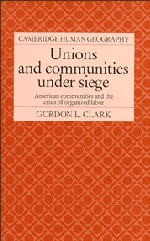Book contents
- Frontmatter
- Contents
- List of tables
- Preface
- Acknowledgments
- PART I ECONOMY AND COMMUNITY
- PART II DRAMA OF ECONOMIC RESTRUCTURING
- PART III UNION PERFORMANCE IN REPRESENTATION ELECTIONS
- PART IV REGULATING LOCAL LABOR–MANAGEMENT RELATIONS
- 8 Integrity of the National Labor Relations Board
- 9 Options for restructuring the US economy
- PART V PROSPECTS FOR ORGANIZED LABOR
- Appendix 1 Variables and data sources
- Appendix 2 Cases cited
- Notes
- Bibliography
- Name index
- Subject index
8 - Integrity of the National Labor Relations Board
Published online by Cambridge University Press: 13 October 2009
- Frontmatter
- Contents
- List of tables
- Preface
- Acknowledgments
- PART I ECONOMY AND COMMUNITY
- PART II DRAMA OF ECONOMIC RESTRUCTURING
- PART III UNION PERFORMANCE IN REPRESENTATION ELECTIONS
- PART IV REGULATING LOCAL LABOR–MANAGEMENT RELATIONS
- 8 Integrity of the National Labor Relations Board
- 9 Options for restructuring the US economy
- PART V PROSPECTS FOR ORGANIZED LABOR
- Appendix 1 Variables and data sources
- Appendix 2 Cases cited
- Notes
- Bibliography
- Name index
- Subject index
Summary
Any understanding of the interrelationships between organized labor and American communities must inevitably consider the role and status of the administrative arm of federal labor law, the National Labor Relations Board. It is the NLRB which is responsible for the administration and interpretation of the National Labor Relations Act. In addition, it is decisions of the Board which have had profound impacts on the economic health of American communities, the success and failure of organized labor in local representation elections, and the extent of managements' prerogatives in terms of the relocation of work, to cite just three of many related dimensions.
The current NLRB was a product of the Wagner Act, signed into law by President Franklin D. Roosevelt on 5 July 1935. Drawing upon the experience of immediate predecessors (the National Labor Board of 1933 and the National Labor Relations Board of 1934), sponsors of the new Board hoped that it would be a unifying but independent force for the administration of federal labor law (see First annual report of the NLRB 1935: ch. 3). In retrospect, achievements of the Act and the Board went well beyond supporters' goals and President Roosevelt's modest ambitions: “an important step toward the achievement of just and peaceful labor relations in industry.”
- Type
- Chapter
- Information
- Unions and Communities under SiegeAmerican Communities and the Crisis of Organized Labor, pp. 151 - 170Publisher: Cambridge University PressPrint publication year: 1989



